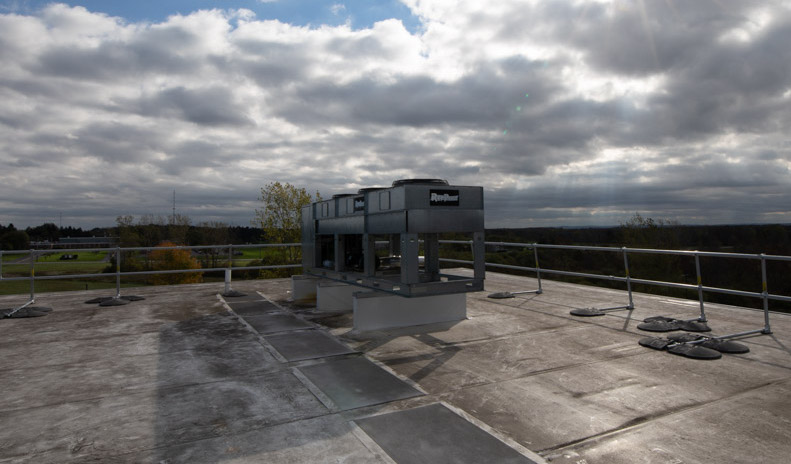What to Know about Guardrail for Rooftop Mechanical Units

If you’re a mechanical contractor, perhaps you can relate to this scenario. You’ve finished installing or replacing some rooftop units and the project seems like it’s just about wrapped up. The building owner will get their certificate of occupancy right on time and you'll get paid so you can move on to the next project. During the final inspection, however, you’re told that the RTUs need guardrail added in order to pass inspection. You’re a mechanical contractor and guardrail may not fall in your typical scope of work... so where do you start?
What does the code say?
Let’s start with what the base requirements are and where they come from. The inspector will likely be looking at the International Mechanical Code (IMC) when citing the need for railing. Here’s a quick look at that code:
IMC 304.11
Guards are to be provided where various components that require service and roof hatch openings are located within 10 feet (3048 mm) of a roof edge… The guard shall extend not less than 30 inches (762 mm) beyond each end of components that require service.
This code states that anytime a unit is within 10 feet of an edge that a guardrail must be provided at a minimum of 30 inches beyond the end of that unit. Let's say the RTU in question is 48 inches wide. This means that only a minimum of 9’ of railing is required by Mechanical code in this case... easy math, right? So... does that mean we are we done here?
What am I missing?
You may be visualizing this specific scenario in your mind and wondering if it’s really that simple. The “thirty inches past” may seem like an arbitrary number and you want to make sure that whatever you do is going to protect workers during further servicing of the units. After all, it is your name on the project and you’re wearing the “fall protection expert” hat for your client now. Some questions you may have at this point would be:
- What happens if someone stumbles past the 30” railing that I install and falls off the roof?
- What about when they are returning to the ladder? Do they need protection there as well?
- Who is liable for the safety of mechanical contractors that come back to service these units?
The dangerous assumption that is often made is that by simply following the Mechanical code and meeting the requirements of the final inspection, you have now ensured the safety of anyone coming onto the roof in the future. The reality is that anytime someone comes to service this unit in the future then they are still violating federal OSHA code, in addition to risking serious injury or death.
I won’t get into the specifics of the OSHA code requirements in this article. OSHA’s requirements are much more comprehensive than the mechanical code requirements mentioned earlier, and while it may not be your responsibility now to follow these codes, you have a unique opportunity to bring these up to the building owner or architect.
What can I do?
This is a great opportunity to provide added value to your client, by equipping them with additional information in the area of fall protection. While fall protection is fresh in their mind, now may be the best time to educate the building owner on all the options that are available to them. They may still elect to do the bare minimum and satisfy the inspection requirements. Or, you may open the door for additional business, in addition to establishing yourself as a subject expert. Either way, you are providing an opportunity to prevent future incidents and avoid OSHA violations down the road.
Not sure where to start? Reach out to a Fall Protection Expert today!

Our team of safety experts is ready to help!



